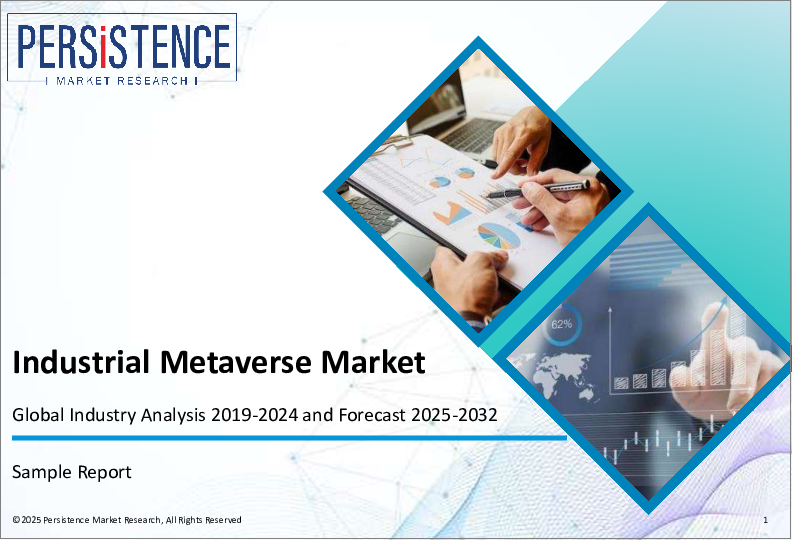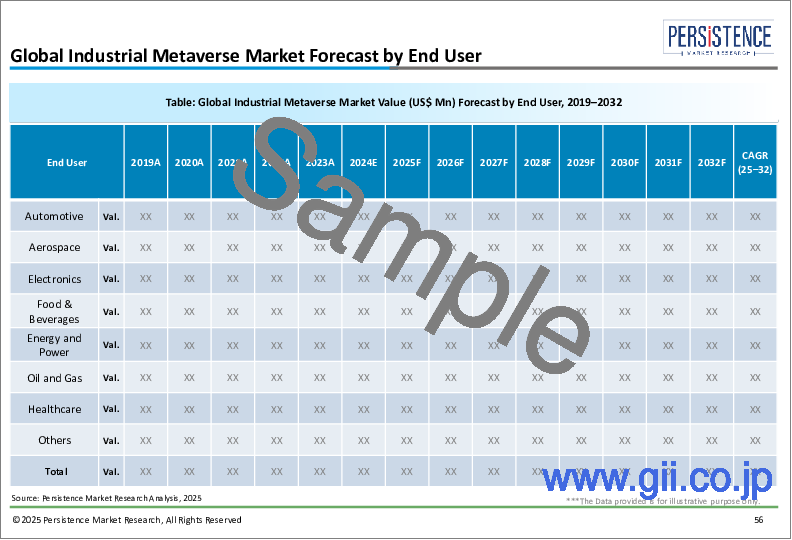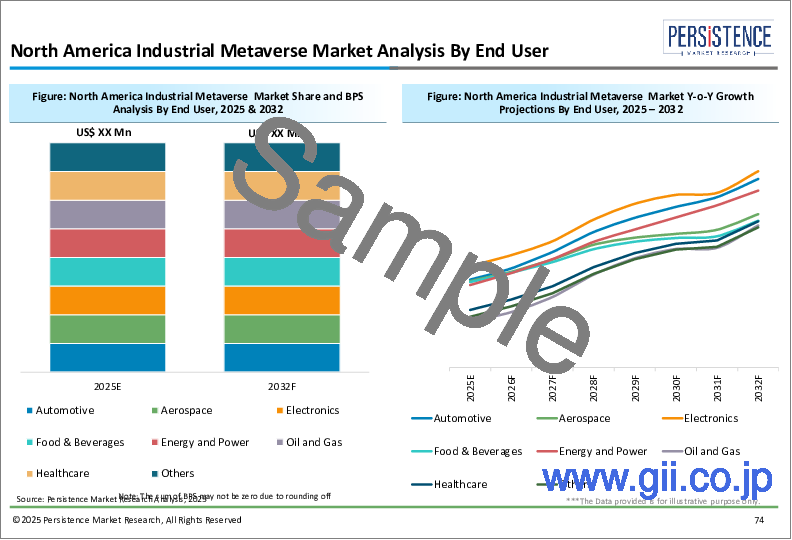|
|
市場調査レポート
商品コード
1801283
産業用メタバース市場:世界の産業分析、市場規模・シェア・成長・動向、将来予測 (2025~2032年)Industrial Metaverse Market: Global Industry Analysis, Size, Share, Growth, Trends, and Forecast, 2025 - 2032 |
||||||
カスタマイズ可能
|
|||||||
| 産業用メタバース市場:世界の産業分析、市場規模・シェア・成長・動向、将来予測 (2025~2032年) |
|
出版日: 2025年08月08日
発行: Persistence Market Research
ページ情報: 英文 250 Pages
納期: 2~5営業日
|
全表示
- 概要
- 目次
Persistence Market Research社はこのほど、世界の産業用メタバース市場に関する包括的な分析を発表しました。当レポートでは、市場促進要因・動向・機会・課題などの重要な市場力学を徹底的に評価し、市場構造に関する詳細な洞察を提供しています。
主要な洞察
- 産業用メタバースの市場規模 (2025年):253億米ドル
- 市場規模の予測 (金額ベース、2032年):1,241億米ドル
- 世界市場の成長率 (CAGR、2025~2032年):25.5%
産業用メタバース市場 - 分析範囲
産業用メタバースは、デジタルツインテクノロジー、IoT、拡張現実(XR)、人工知能(AI)の融合を意味し、製造、エンジニアリング、ロジスティクス、エネルギー分野におけるリアルタイムの没入型シミュレーションとコラボレーションを可能にします。よりスマートな意思決定、予知保全、作業員トレーニング、仮想プロトタイピングを促進し、業務効率とイノベーション・パイプラインを変革します。同市場は、デジタル産業アプリケーション向けに調整されたソフトウェアプラットフォーム、ハードウェアインフラ、サービスエコシステムを包含します。
市場成長の促進要因:
世界の産業用メタバース市場は、インダストリー4.0原則の採用の増加、リモートコラボレーションツールの需要、生産環境における高度なシミュレーションと可視化のニーズの高まりなど、複数の要因によって推進されています。デジタルツインとAIやXRの統合は、ダウンタイムを削減し、資産利用率を向上させるリアルタイムのモニタリングと予測機能を提供します。危険な産業環境における持続可能性、コスト効率、作業員の安全性を重視する傾向が強まっており、市場の導入がさらに加速しています。さらに、COVID-19の大流行がデジタルトランスフォーメーションへの関心を増幅し、メタバース関連インフラへの投資を加速させています。
市場の抑制要因:
堅調な成長の可能性にもかかわらず、産業用メタバース市場は、データプライバシー、相互運用性、高額な初期費用に関する課題に直面しています。産業組織は、レガシーシステムと最新のメタバースプラットフォームの統合に苦労することが多く、本格的な展開が制限されます。セキュリティの脆弱性や、没入型データ交換のための標準化されたプロトコルの欠如は、産業環境をサイバーリスクにさらす可能性があります。さらに、デジタルツイン作成の複雑さとXRおよびAI分野の人材不足は、メタバース・ソリューションの導入を目指す企業に運用上の制約をもたらします。
市場機会:
産業用メタバース市場は、クラウドコンピューティング、5Gコネクティビティ、AI主導のアナリティクスの融合が進むことによって、大きな成長機会をもたらしています。産業トレーニング、サプライチェーンの透明性、リアルタイム・コラボレーションにおける新たな使用事例は、重要な価値提案を生み出します。メタバース・プラットフォーム・プロバイダーと産業大手とのパートナーシップは、新たな収益源を解き放ち、プロセス自動化と設計検証におけるイノベーションを促進しています。AR/VRハードウェア機能の拡大とIoTセンサーのコスト低下は、普及をさらに促進します。スマート工場とデジタルインフラに投資する政府と企業は、世界の産業用メタバースエコシステムをリードする態勢を整えています。
当レポートで回答する主な質問
- 世界の産業用メタバース市場の成長を促進する主な要因は何か?
- 産業用メタバースの利用事例の急速な進化に貢献している技術と活用領域は何か?
- デジタルツインプラットフォームとXRは、産業オペレーションと人材育成をどのように再構築しているのか?
- 産業用メタバース市場に貢献している主要プレイヤーは誰で、市場のリーダーシップを維持するためにどのような戦略を採用しているのか?
- 世界の産業用メタバース市場における新たな動向と将来性は?
目次
第1章 エグゼクティブサマリー
第2章 市場概要
- 市場の範囲と定義
- バリューチェーン分析
- マクロ経済要因
- 世界のGDP見通し
- 世界経済成長予測
- 世界の都市化の進展
- その他のマクロ経済要因
- 予測要因:関連性と影響
- COVID-19の影響評価
- PESTLE分析
- ポーターのファイブフォース分析
- 地政学的緊張:市場への影響
- 規制と技術の情勢
第3章 市場力学
- 促進要因
- 抑制要因
- 機会
- 動向
第4章 価格動向分析 (2019~2032年)
- 地域別価格分析
- セグメント別の価格
- 価格の影響要因
第5章 世界の産業用メタバース市場の展望:過去 (2019~2024年) と予測 (2025~2032年)
- 主なハイライト
- 世界の産業用メタバース市場の展望:技術別
- イントロダクション/主な分析結果
- 過去の市場規模の実績:技術別 (金額ベース、2019~2024年)
- 現在の市場規模の予測:技術別 (金額ベース、2025~2032年)
- 仮想現実(VR)
- 拡張現実(AR)
- 複合現実(MR)
- 市場の魅力分析:技術別
- 世界の産業用メタバース市場の展望:用途別
- イントロダクション/主な分析結果
- 過去の市場規模の実績:用途別 (金額ベース、2019~2024年)
- 現在の市場規模の予測:用途別 (金額ベース、2025~2032年)
- トレーニング・シミュレーション
- リモートコラボレーション
- 製品設計・開発
- 資産運用管理
- サプライチェーン管理
- カスタマーサービス
- 製造業
- ロジスティクス
- 医療
- 教育
- 市場の魅力分析:用途別
第6章 世界の産業用メタバース市場の展望:地域別
- 主なハイライト
- 過去の市場規模の分析:地域別 (金額ベース、2019~2024年)
- 現在の市場規模の予測:地域別 (金額ベース、2025~2032年)
- 北米
- 欧州
- 東アジア
- 南アジア・オセアニア
- ラテンアメリカ
- 中東・アフリカ
- 市場の魅力分析:地域別
第7章 北米の産業用メタバース市場の展望:過去(2019~2024年)と予測(2025~2032年)
第8章 欧州の産業用メタバース市場の展望:過去(2019~2024年)と予測(2025~2032年)
第9章 東アジアの産業用メタバース市場の展望:過去(2019~2024年)と予測(2025~2032年)
第10章 南アジア・オセアニアの産業用メタバース市場の展望:過去(2019~2024年)と予測(2025~2032年)
第11章 ラテンアメリカの産業用メタバース市場の展望:過去(2019~2024年)と予測(2025~2032年)
第12章 中東・アフリカの産業用メタバース市場の展望:過去(2019~2024年)と予測(2025~2032年)
第13章 競合情勢
- 市場シェア分析、2025年
- 市場構造
- 競合強度マッピング
- 競合ダッシュボード
- 企業プロファイル
- Microsoft
- Meta
- Unity Software
- Epic Games
- NVIDIA
- HTC
- Sony
- Magic Leap
- Apple
第14章 付録
- 分析手法
- 分析の前提
- 頭字語と略語
Persistence Market Research has recently released a comprehensive report on the worldwide market for Industrial Metaverse. The report offers a thorough assessment of crucial market dynamics, including drivers, trends, opportunities, and challenges, providing detailed insights into the market structure.
Key Insights:
- Industrial Metaverse Market Size (2025E): USD 25.3 Billion
- Projected Market Value (2032F): USD 124.1 Billion
- Global Market Growth Rate (CAGR 2025 to 2032): 25.5%
Industrial Metaverse Market - Report Scope:
The industrial metaverse represents a convergence of digital twin technologies, IoT, extended reality (XR), and artificial intelligence (AI), enabling real-time, immersive simulations and collaboration in manufacturing, engineering, logistics, and energy sectors. It facilitates smarter decision-making, predictive maintenance, workforce training, and virtual prototyping, transforming operational efficiency and innovation pipelines. The market encompasses software platforms, hardware infrastructure, and service ecosystems tailored for digital industrial applications.
Market Growth Drivers:
The global industrial metaverse market is propelled by multiple factors, including the increasing adoption of Industry 4.0 principles, the demand for remote collaboration tools, and the rising need for advanced simulation and visualization in production environments. Integration of digital twins with AI and XR provides real-time monitoring and predictive capabilities that reduce downtime and improve asset utilization. The growing emphasis on sustainability, cost-efficiency, and worker safety in hazardous industrial settings further accelerates market adoption. Furthermore, the COVID-19 pandemic amplified interest in digital transformation, accelerating investments in metaverse-related infrastructure.
Market Restraints:
Despite robust growth potential, the industrial metaverse market faces challenges related to data privacy, interoperability, and high upfront costs. Industrial organizations often struggle with integrating legacy systems with modern metaverse platforms, limiting full-scale deployment. Security vulnerabilities and lack of standardized protocols for immersive data exchange can expose industrial environments to cyber risks. Additionally, the complexity of digital twin creation and talent shortages in XR and AI fields pose operational constraints for enterprises aiming to implement metaverse solutions.
Market Opportunities:
The industrial metaverse market presents vast growth opportunities, driven by the increasing convergence of cloud computing, 5G connectivity, and AI-driven analytics. Emerging use cases in industrial training, supply chain transparency, and real-time collaboration create significant value propositions. Partnerships between metaverse platform providers and industrial giants are unlocking novel revenue streams and driving innovation in process automation and design validation. The expansion of AR/VR hardware capabilities and decreasing costs of IoT sensors further catalyze widespread adoption. Governments and enterprises investing in smart factories and digital infrastructure are poised to lead in the global industrial metaverse ecosystem.
Key Questions Answered in the Report:
- What are the primary factors driving the growth of the industrial metaverse market globally?
- Which technologies and applications are contributing to the rapid evolution of industrial metaverse use cases?
- How are digital twin platforms and XR reshaping industrial operations and workforce training?
- Who are the key players contributing to the industrial metaverse market, and what strategies are they employing to maintain market leadership?
- What are the emerging trends and future prospects in the global industrial metaverse market?
Competitive Intelligence and Business Strategy:
Leading players in the global industrial metaverse market, including Siemens AG, NVIDIA Corporation, Microsoft Corporation, and Hexagon AB, focus on technological innovation, ecosystem partnerships, and platform scalability to gain a competitive edge. These companies invest in R\&D to develop interoperable digital twin frameworks, real-time 3D rendering solutions, and XR training environments for industrial use. Collaborations with manufacturing firms, robotics companies, and cloud service providers facilitate ecosystem expansion and accelerate market penetration. Emphasis on standardization, cybersecurity, and user-centric design enhances trust and usability in the evolving industrial metaverse landscape.
Key Companies Profiled:
- Microsoft
- Meta
- Unity Software
- Epic Games
- NVIDIA
- HTC
- Sony
- Magic Leap
- Apple
Industrial Metaverse Market Research Segmentation:
By Technology:
- Virtual reality (VR)
- Augmented reality (AR)
- Mixed reality (MR)
By Application:
- Training and Simulation
- Remote Collaboration
- Product Design and Development
- Asset Management
- Supply Chain Management
- Customer Service
- Manufacturing
- Logistics
- Healthcare
- Education
By Region:
- North America
- Latin America
- Europe
- Asia Pacific
- Middle East and Africa
Table of Contents
1. Executive Summary
- 1.1. Global Industrial Metaverse Market Snapshot 2025 and 2032
- 1.2. Market Opportunity Assessment, 2025-2032, US$ Mn
- 1.3. Key Market Trends
- 1.4. Industry Developments and Key Market Events
- 1.5. Demand Side and Supply Side Analysis
- 1.6. PMR Analysis and Recommendations
2. Market Overview
- 2.1. Market Scope and Definitions
- 2.2. Value Chain Analysis
- 2.3. Macro-Economic Factors
- 2.3.1. Global GDP Outlook
- 2.3.2. Global GDP Outlook
- 2.3.3. Global economic Growth Forecast
- 2.3.4. Global Urbanization Growth
- 2.3.5. Other Macro-economic Factors
- 2.4. Forecast Factors - Relevance and Impact
- 2.5. COVID-19 Impact Assessment
- 2.6. PESTLE Analysis
- 2.7. Porter's Five Forces Analysis
- 2.8. Geopolitical Tensions: Market Impact
- 2.9. Regulatory and Technology Landscape
3. Market Dynamics
- 3.1. Drivers
- 3.2. Restraints
- 3.3. Opportunities
- 3.4. Trends
4. Price Trend Analysis, 2019-2032
- 4.1. Region-wise Price Analysis
- 4.2. Price by Segments
- 4.3. Price Impact Factors
5. Global Industrial Metaverse Market Outlook: Historical (2019-2024) and Forecast (2025-2032)
- 5.1. Key Highlights
- 5.2. Global Industrial Metaverse Market Outlook: Technology
- 5.2.1. Introduction/Key Findings
- 5.2.2. Historical Market Size (US$ Mn) Analysis by Technology, 2019-2024
- 5.2.3. Current Market Size (US$ Mn) Forecast, by Technology, 2025-2032
- 5.2.3.1. Virtual reality (VR)
- 5.2.3.2. Augmented reality (AR)
- 5.2.3.3. Mixed reality (MR)
- 5.2.4. Market Attractiveness Analysis: Technology
- 5.3. Global Industrial Metaverse Market Outlook: Application
- 5.3.1. Introduction/Key Findings
- 5.3.2. Historical Market Size (US$ Mn) Analysis by Application, 2019-2024
- 5.3.3. Current Market Size (US$ Mn) Forecast, by Application, 2025-2032
- 5.3.3.1. Training and Simulation
- 5.3.3.2. Remote Collaboration
- 5.3.3.3. Product Design and Development
- 5.3.3.4. Asset Management
- 5.3.3.5. Supply Chain Management
- 5.3.3.6. Customer Servic
- 5.3.3.7. Manufacturing
- 5.3.3.8. Logistics
- 5.3.3.9. Healthcare
- 5.3.3.10. Education
- 5.3.4. Market Attractiveness Analysis: Application
6. Global Industrial Metaverse Market Outlook: Region
- 6.1. Key Highlights
- 6.2. Historical Market Size (US$ Mn) Analysis by Region, 2019-2024
- 6.3. Current Market Size (US$ Mn) Forecast, by Region, 2025-2032
- 6.3.1. North America
- 6.3.2. Europe
- 6.3.3. East Asia
- 6.3.4. South Asia & Oceania
- 6.3.5. Latin America
- 6.3.6. Middle East & Africa
- 6.4. Market Attractiveness Analysis: Region
7. North America Industrial Metaverse Market Outlook: Historical (2019-2024) and Forecast (2025-2032)
- 7.1. Key Highlights
- 7.2. Pricing Analysis
- 7.3. North America Market Size (US$ Mn) Forecast, by Country, 2025-2032
- 7.3.1. U.S.
- 7.3.2. Canada
- 7.4. North America Market Size (US$ Mn) Forecast, by Technology, 2025-2032
- 7.4.1. Virtual reality (VR)
- 7.4.2. Augmented reality (AR)
- 7.4.3. Mixed reality (MR)
- 7.5. North America Market Size (US$ Mn) Forecast, by Application, 2025-2032
- 7.5.1. Training and Simulation
- 7.5.2. Remote Collaboration
- 7.5.3. Product Design and Development
- 7.5.4. Asset Management
- 7.5.5. Supply Chain Management
- 7.5.6. Customer Servic
- 7.5.7. Manufacturing
- 7.5.8. Logistics
- 7.5.9. Healthcare
- 7.5.10. Education
8. Europe Industrial Metaverse Market Outlook: Historical (2019-2024) and Forecast (2025-2032)
- 8.1. Key Highlights
- 8.2. Pricing Analysis
- 8.3. Europe Market Size (US$ Mn) Forecast, by Country, 2025-2032
- 8.3.1. Germany
- 8.3.2. Italy
- 8.3.3. France
- 8.3.4. U.K.
- 8.3.5. Spain
- 8.3.6. Russia
- 8.3.7. Rest of Europe
- 8.4. Europe Market Size (US$ Mn) Forecast, by Technology, 2025-2032
- 8.4.1. Virtual reality (VR)
- 8.4.2. Augmented reality (AR)
- 8.4.3. Mixed reality (MR)
- 8.5. Europe Market Size (US$ Mn) Forecast, by Application, 2025-2032
- 8.5.1. Training and Simulation
- 8.5.2. Remote Collaboration
- 8.5.3. Product Design and Development
- 8.5.4. Asset Management
- 8.5.5. Supply Chain Management
- 8.5.6. Customer Servic
- 8.5.7. Manufacturing
- 8.5.8. Logistics
- 8.5.9. Healthcare
- 8.5.10. Education
9. East Asia Industrial Metaverse Market Outlook: Historical (2019-2024) and Forecast (2025-2032)
- 9.1. Key Highlights
- 9.2. Pricing Analysis
- 9.3. East Asia Market Size (US$ Mn) Forecast, by Country, 2025-2032
- 9.3.1. China
- 9.3.2. Japan
- 9.3.3. South Korea
- 9.4. East Asia Market Size (US$ Mn) Forecast, by Technology, 2025-2032
- 9.4.1. Virtual reality (VR)
- 9.4.2. Augmented reality (AR)
- 9.4.3. Mixed reality (MR)
- 9.5. East Asia Market Size (US$ Mn) Forecast, by Application, 2025-2032
- 9.5.1. Training and Simulation
- 9.5.2. Remote Collaboration
- 9.5.3. Product Design and Development
- 9.5.4. Asset Management
- 9.5.5. Supply Chain Management
- 9.5.6. Customer Servic
- 9.5.7. Manufacturing
- 9.5.8. Logistics
- 9.5.9. Healthcare
- 9.5.10. Education
10. South Asia & Oceania Industrial Metaverse Market Outlook: Historical (2019-2024) and Forecast (2025-2032)
- 10.1. Key Highlights
- 10.2. Pricing Analysis
- 10.3. South Asia & Oceania Market Size (US$ Mn) Forecast, by Country, 2025-2032
- 10.3.1. India
- 10.3.2. Southeast Asia
- 10.3.3. ANZ
- 10.3.4. Rest of SAO
- 10.4. South Asia & Oceania Market Size (US$ Mn) Forecast, by Technology, 2025-2032
- 10.4.1. Virtual reality (VR)
- 10.4.2. Augmented reality (AR)
- 10.4.3. Mixed reality (MR)
- 10.5. South Asia & Oceania Market Size (US$ Mn) Forecast, by Application, 2025-2032
- 10.5.1. Training and Simulation
- 10.5.2. Remote Collaboration
- 10.5.3. Product Design and Development
- 10.5.4. Asset Management
- 10.5.5. Supply Chain Management
- 10.5.6. Customer Servic
- 10.5.7. Manufacturing
- 10.5.8. Logistics
- 10.5.9. Healthcare
- 10.5.10. Education
11. Latin America Industrial Metaverse Market Outlook: Historical (2019-2024) and Forecast (2025-2032)
- 11.1. Key Highlights
- 11.2. Pricing Analysis
- 11.3. Latin America Market Size (US$ Mn) Forecast, by Country, 2025-2032
- 11.3.1. Brazil
- 11.3.2. Mexico
- 11.3.3. Rest of LATAM
- 11.4. Latin America Market Size (US$ Mn) Forecast, by Technology, 2025-2032
- 11.4.1. Virtual reality (VR)
- 11.4.2. Augmented reality (AR)
- 11.4.3. Mixed reality (MR)
- 11.5. Latin America Market Size (US$ Mn) Forecast, by Application, 2025-2032
- 11.5.1. Training and Simulation
- 11.5.2. Remote Collaboration
- 11.5.3. Product Design and Development
- 11.5.4. Asset Management
- 11.5.5. Supply Chain Management
- 11.5.6. Customer Servic
- 11.5.7. Manufacturing
- 11.5.8. Logistics
- 11.5.9. Healthcare
- 11.5.10. Education
12. Middle East & Africa Industrial Metaverse Market Outlook: Historical (2019-2024) and Forecast (2025-2032)
- 12.1. Key Highlights
- 12.2. Pricing Analysis
- 12.3. Middle East & Africa Market Size (US$ Mn) Forecast, by Country, 2025-2032
- 12.3.1. GCC Countries
- 12.3.2. South Africa
- 12.3.3. Northern Africa
- 12.3.4. Rest of MEA
- 12.4. Middle East & Africa Market Size (US$ Mn) Forecast, by Technology, 2025-2032
- 12.4.1. Virtual reality (VR)
- 12.4.2. Augmented reality (AR)
- 12.4.3. Mixed reality (MR)
- 12.5. Middle East & Africa Market Size (US$ Mn) Forecast, by Application, 2025-2032
- 12.5.1. Training and Simulation
- 12.5.2. Remote Collaboration
- 12.5.3. Product Design and Development
- 12.5.4. Asset Management
- 12.5.5. Supply Chain Management
- 12.5.6. Customer Servic
- 12.5.7. Manufacturing
- 12.5.8. Logistics
- 12.5.9. Healthcare
- 12.5.10. Education
13. Competition Landscape
- 13.1. Market Share Analysis, 2025
- 13.2. Market Structure
- 13.2.1. Competition Intensity Mapping
- 13.2.2. Competition Dashboard
- 13.3. Company Profiles
- 13.3.1. Microsoft
- 13.3.1.1. Company Overview
- 13.3.1.2. Product Portfolio/Offerings
- 13.3.1.3. Key Financials
- 13.3.1.4. SWOT Analysis
- 13.3.1.5. Company Strategy and Key Developments
- 13.3.2. Meta
- 13.3.3. Unity Software
- 13.3.4. Epic Games
- 13.3.5. NVIDIA
- 13.3.6. HTC
- 13.3.7. Sony
- 13.3.8. Magic Leap
- 13.3.9. Apple
- 13.3.10. Google
- 13.3.1. Microsoft
14. Appendix
- 14.1. Research Methodology
- 14.2. Research Assumptions
- 14.3. Acronyms and Abbreviations






